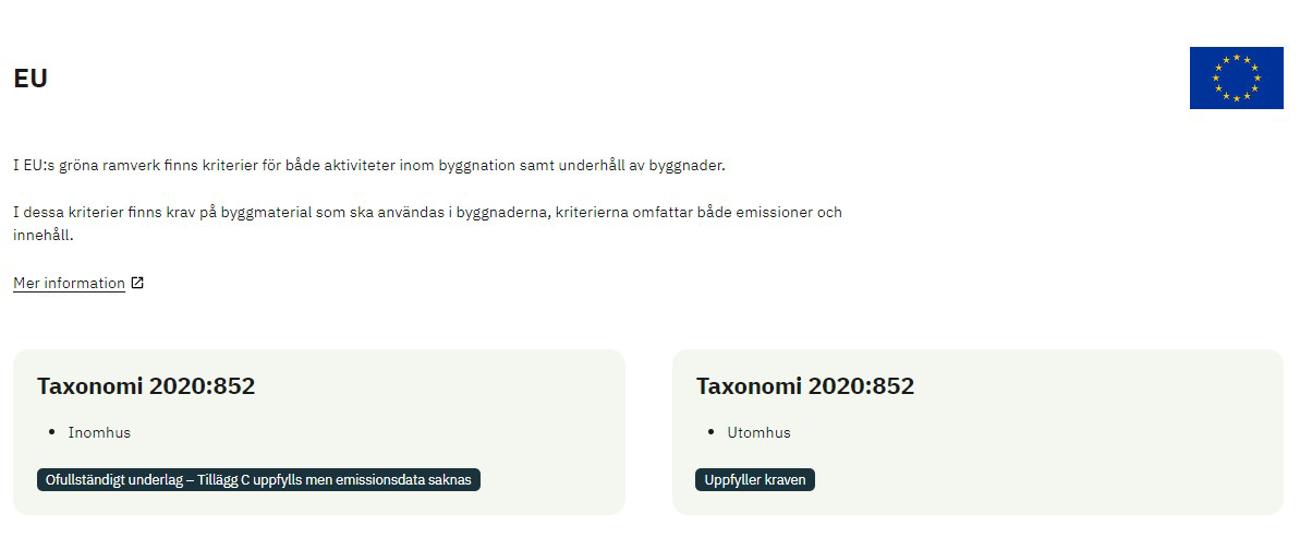EU Taxonomy
The EU taxonomy regulation is a classification system for environmentally sustainable activities within the EU. The purpose of the regulation is, among other things, to introduce common definitions of what is sustainable, and thus make it easier for investors to make sustainable investments. An investment is defined as sustainable if it significantly contributes to one of the six environmental goals established in the taxonomy, while it does not contribute negatively to any of the other goals, and fulfills fundamental rights in social sustainability.
The developed framework affects a number of economic activities within the EU, among other things there are criteria for activities in the construction and maintenance of buildings that set requirements for the building materials to be used. Criteria for building materials and building elements are described in technical review criteria. For building materials and hazardous substances, the so-called Do no significant harm (DNSH) criteria in Appendix C within the taxonomy are central and decisively influence the work done in the various assessment systems.
How the industry works?
In the fall of 2022, the assessment companies started a collaborative group that grew to include actors from the entire industry. Today, the group is part of Byggföretagen's taxonomy network. The following organizations are included:
- Assessment companies - BASTA, Byggvarubedomningen & SundaHus
- Certification body - The Nordic Swan, SGBC
- Construction companies - Byggföretagen, Fabege, NCC, PEAB, Serneke, Skanska, Sweden's public utility, Veidekke, etc.
- Material manufacturers - Byggmaterialindustriern/KTF, VVS Fabrikarterna
The goal of the collaboration is to find a common approach to the taxonomy with a focus on hazardous substances in building materials. We want to make sure of a solution that works on the Swedish market and that gives both manufacturers/suppliers and the person who is going to buy a product reliable, and verifiable, information. The network has closely followed the evolution of the taxonomy through published clarifications and the most recently published addendum to the delegated act and the remaining environmental targets
In addition, BASTA leads a group within Byggföretagen and Fastighetsägarna that focuses on the taxonomy's material requirements.
Status today
In this group, a working method has been worked out, which has been presented and accepted in the Taxonomy Network of Byggföretagen and Fastighetsägarna.
This proposal is now published on this page: Click here.
Navigation
Which economic activities are covered by the taxonomy?
- Forestry
- Environmental protection and restoration activities
- Manufacturing
- Energy
- Water supply, sewage treatment, waste management and sanitation
- Transportation
- Construction and real estate operations
- Information and communication
- Highly specialized, scientific and technical activities
Which activities are covered within construction and real estate operations?
- 7.1 Construction of new buildings
- 7.2 Renovation of existing buildings
- 7.3 Installation, maintenance and repair of energy-efficient equipment
- 7.4 Installation, maintenance and repair of charging stations for electric vehicles in buildings (and parking spaces adjacent to buildings)
- 7.5 Installation, maintenance and repair of instruments and devices for measuring, regulating and controlling the energy performance of buildings
- 7.6 Installation, maintenance and repair of renewable energy technologies
- 7.7 Acquisition and ownership of buildings
Which activities include material requirements?
-
7.1 Construction of new buildings - DNSH for "Prevention and Limitation of Environmental Pollution"
-
Appendix C & Emissions
-
-
7.2 Renovation of existing buildings - DNSH for "Prevention and Limitation of Environmental Pollution"
-
Appendix C & Emissions
-
-
7.3 Installation, maintenance and repair of energy efficient equipment - DNSH for "Prevention and Limitation of Environmental Pollution"
-
Appendix C
-
The requirements for hazardous substances are described in Appendix C and the emission requirements directly in the DNSH criteria
The requirements in the taxonomy:
In DNSH - Reference to Addendum C / Appendix C and emission requirements
Building components and materials used in the construction comply with the criteria set out in Appendix C to this Annex.
Building components and materials used in the construction that may come into contact with occupiers(89) emit less than 0,06 mg of formaldehyde per m3 of test chamber air upon testing in accordance with the conditions specified in Annex XVII to Regulation (EC) No 1907/2006 and less than 0,001 mg of other categories 1A and 1B carcinogenic volatile organic compounds per m3 of test chamber air, upon testing in accordance with CEN/EN 16516(90) or ISO 16000-3:2011(91) or other equivalent standardised test conditions and determination methods(92).
- (89) Applying to paints and varnishes, ceiling tiles, floor coverings, including associated adhesives and sealants, internal insulation and interior surface treatments, such as to treat damp and mould.
- (90) CEN/TS 16516: 2013, Construction products – Assessment of release of dangerous substances –Determination of emissions into indoor air.
- (91) ISO 16000-3:2011, Indoor air — Part 3: Determination of formaldehyde and other carbonyl compounds in indoor air and test chamber air — Active sampling method.
- (92) The emissions thresholds for carcinogenic volatile organic compounds relate to a 28-day test period.
Appendix C
GENERIC CRITERIA FOR DNSH TO POLLUTION PREVENTION AND CONTROL REGARDING USE AND PRESENCE OF CHEMICALS
The activity does not lead to the manufacture, placing on the market or use of:
a) substances, whether on their own, in mixtures or in articles, listed in Annexes I or II to Regulation (EU) 2019/1021, except in the case of substances present as an unintentional trace contaminant;
b) mercury and mercury compounds, their mixtures and mercury-added products as defined in Article 2 of Regulation (EU) 2017/852 ;
c) substances, whether on their own, in mixture or in articles, listed in Annexes I or II to Regulation (EC) No 1005/2009;
d) substances, whether on their own, in mixtures or in an articles, listed in Annex II to Directive 2011/65/EU, except where there is full compliance with Article 4(1) of that Directive;
e) substances, whether on their own, in mixtures or in an article, listed in Annex XVII to Regulation (EC) 1907/2006, except where there is full compliance with the conditions specified in that Annex;
f) substances, whether on their own, or in mixtures or in an article, in a concentration above 0,1 % weight by weight (w/w), and meeting the criteria laid down in Article 57 of Regulation (EC) 1907/2006 and that were identified in accordance with Article 59(1) of that Regulation for a period of at least 18 months, except if it is assessed and documented by the operators that no other suitable alternative substances or technologies are available on the market, and that they are used under controlled conditions*1
*1 The Commission will review the exceptions from the prohibition from manufacturing, placing on the market or use of the substances referred to in point (f) once it will have published horizontal principles on essential use of chemicals
In addition, the activity does not lead to the manufacture, presence in the final product or output, or placing on the market, of other substances, whether on their own, or in mixtures or in an article, in a concentration above 0,1% weight by weight (w/w), that meet the criteria of Regulation (EC) No 1272/2008 in one of the hazard classes or hazard categories mentioned in Article 57 of Regulation (EC) 1907/2006, except if it is assessed and documented by the operators that no other suitable alternative substances or technologies are available on the market, and that they are used under controlled conditions*2


The emission requirements
- Testing for formaldehyde can be done with equivalent test methods to Annex XVII. ISO 16516 is assessed as an equivalent test method
- Testing must be carried out on the product types specified in footnote (89). This means that the following product types, "paints and varnishes, ceiling tiles, floor coverings, including associated adhesives and sealants, internal insulation and interior surface treatments, such as to treat damp and mould", must meet the emission requirements
- Products that do not contain organic materials do not need to be emissions tested
Appendix C
Point a)-e)
No extra control of these points is needed (however, the assessment systems have criteria that still capture the majority of these criteria)
Point f)
Point f) must be checked as it goes beyond the legislation. Substances on the candidate list must not be present in concentrations above 0.1% by weight
"New point after f)"
Against the background of the argument that this point needs implementation time according to the arguments for the addition to the existing environmental goals and that the DNSH criteria must be the same for all environmental goals, this criterion is considered to apply on January 1, 2025 for all environmental goals.
These criteria have been incorporated into the BASTA system's criteria V.34, which applies from 1 August 2024.
The emission requirements
Information that may be provided:
In order to meet the emission requirements, it is possible to provide the following information about formaldehyde (Criterion E2: Formaldehyde) and carcinogenic volatile organic substances (Criterion E3: Carcinogenic volatile organic compounds).
- Measurement method/standard
- Measured concentration
- If the article is exempt from emission measurement due to the fact that it does not contain any organic material
- If the measurement method specified under point 1 an approved measurement method according to the DNSH criteria for the environmental objective "Prevention and control of pollution" in the EU taxonomy 2020/852/EU
- If the article is covered by the product types that, according to the DNSH criteria for the environmental objective "Prevention and control of pollution" must meet emission requirements in the EU taxonomy
What is required to fulfill the requirements of the taxonomy:
To be approved for the emission requirements, the product must meet one of the following scenarios (for both criteria E2 & E3):
- Exempted from emission measurement due to the fact that it does not contain any organic material (Point 3 above)
- Not covered by the product types covered by the taxonomy's emission requirements (Point 5 above)
- Have an emission value below the limit value according to the taxonomy (Point 2 above), have a specified measurement method/standard (Point 1 above) and have confirmed that the specified measurement method is approved according to the taxonomy (Point 4 above)
Appendix C
Point a)-e)
No extra checking of these points is needed
Point f)
That BASTA's criterion H11.A is met
"New point after f)"
Implemented from 1st January 2025.

Remaining questions
Pending the final clarifications, the agreed working method described below is now being applied. When clarifications are published, the way of working may need to change.
The Commission continuously has a "stakeholder request mechanism" where stakeholders can provide input on the taxonomy criteria. Questions and comments described below were submitted before 15 December 2023, this means they will be processed by the EU and feedback will be provided shortly.
